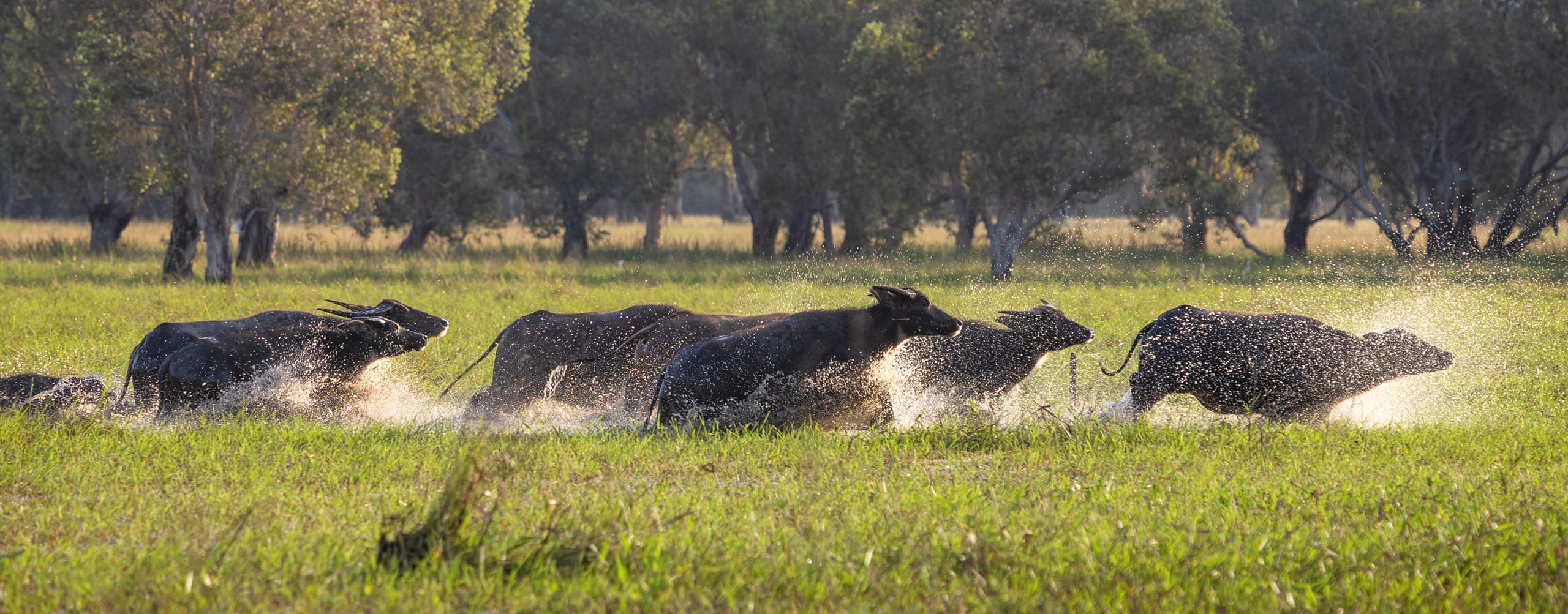
Over the top
An overland journey through Arnhem Land is a ticket to a world filled with Indigenous culture and wildlife.
STORY + PHOTOS MARK DAFFEY | OUTBACK MAGAZINE
The final 8km descent towards Arnhem Land’s Murwangi Safari Camp is easily the smoothest section of road during the long drive from the Gove Peninsula township of Nhulunbuy. From the monotony of driving over unsealed roads across a forested tabletop escarpment for hours on end, visitors on the dusty track emerge from savanna woodlands into floodplains that are teeming with wildlife, both native and introduced.
Brumbies, cattle and buffaloes are all sighted on the graded approach into camp. Cathedral termite mounds that are hundreds of years old tower above rust-coloured soils that soak up metres of rain during the wet. Above, whistling kites share smoky skies with gaggles of handsome magpie geese, while hidden somewhere among the spinifex clumps and paperbark trees are venomous snakes and spiders.
“Where we are now standing is part of the Arafura Swamp region, the largest freshwater ecosystem in Arnhem Land,” camp manager Keith Hamelink says. “It’s also the largest paperbark swamp in Australia, spreading across an area measuring 1,350sq km during the wet season.
“The thing you need to remember is that every animal around here is wild. There are 80 brumbies, even more wild cattle – Shorthorn and Brahman – and an estimated 200,000 buffaloes. And believe me, they are not to be messed with.”

Observation Point, Port Essington.
The sodden country around the Outback Spirit-owned camp is arguably Australia’s version of the Okavango Delta in southern Africa. Few other places around our nation can compare to the sheer volume of wildlife sighted here during leisurely cruises along the Glyde River lagoon or on 4WD safaris through some of the most extensive paperbark forests on Earth. It isn’t uncommon for buffaloes and brumbies to stroll past the steps of the camp’s luxury tented accommodation as guests step out onto their deck area at dawn, or to be lurking among the bushes separating their tents from the lagoon as they traipse back to their beds after a hearty meal in the camp dining room.
Murwangi marks the first stop on the only commercial overland tours across Arnhem Land. Outback Spirit’s 13-day Arnhem Land Wilderness Adventure tours run every second or third day from May to September. Guest accommodation throughout the tour ranges from clean, comfortable lodges and safari-style glamping tents to breezy ensuite cabins and luxury habitat villas. Outback Spirit currently owns 3 of the 5 accommodation stays – Murwangi, Barramundi Lodge and Seven Spirit Bay.
Barramundi Lodge teeters on the edge of an escarpment that overlooks the Central Arnhem Land floodplains, close to the Aboriginal community of Maningrida. Anglers keen on hooking juicy barramundis have eagerly beat a path here since it opened in 1988. It was refurbished after the company purchased the lodge in 2015.
The accommodation tents and dining room at Murwangi were built on the property in 2016, after decades of operations as a cattle station with its own onsite abattoir and market garden. That year Outback Spirit also acquired Seven Spirit Bay, the opulent resort overlooking Coral Bay in West Arnhem Land, adding a pampered guest experience to end the 13-day tours. The resort, which is only accessible by boat or air, is also open for short stays.
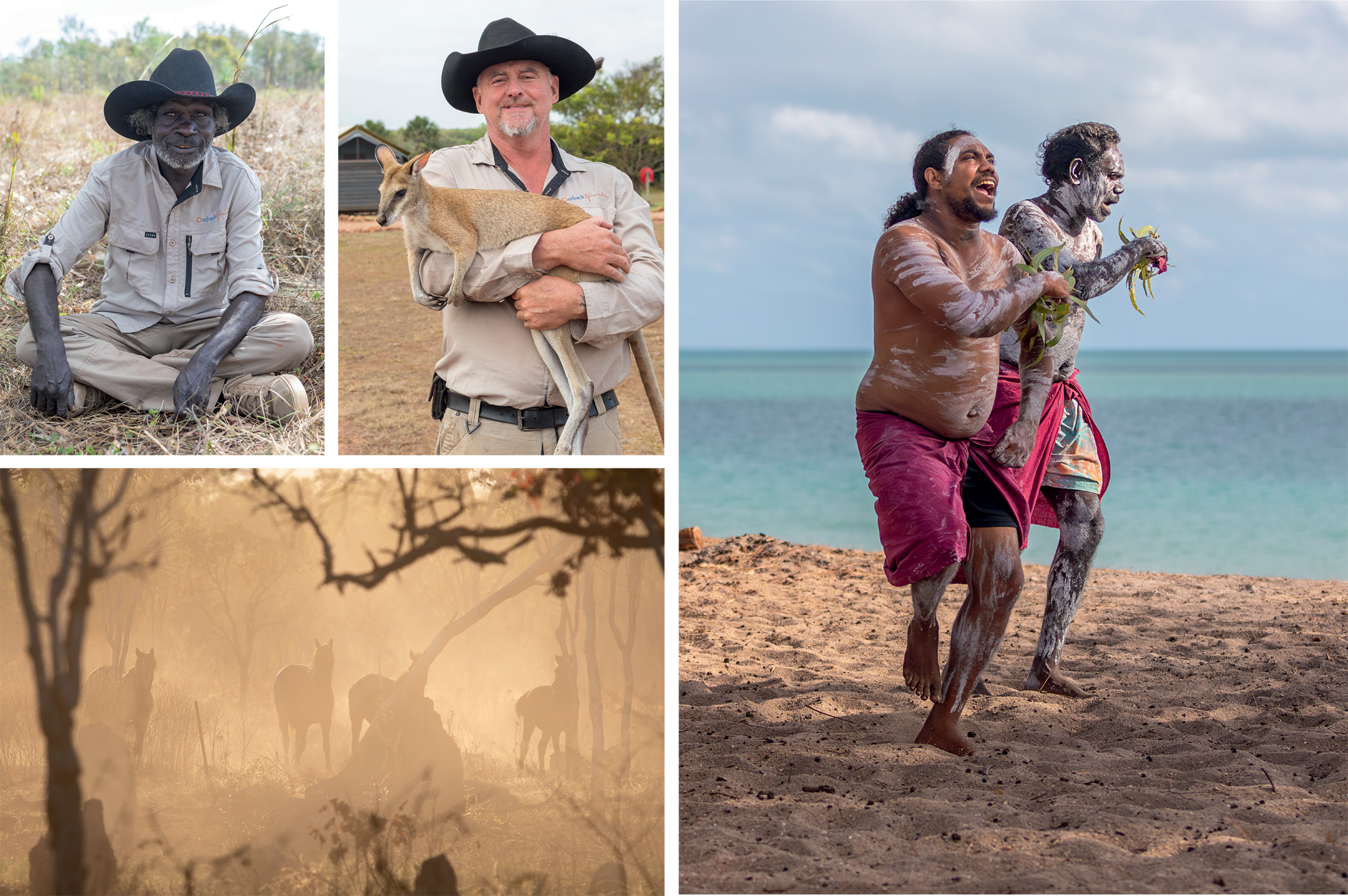
Bungul welcome ceremony dancers on Wirrwawuy Beach; brumbies, Murwangi Safari
Camp; Traditional Owner and Murwangi Safari Camp guide, Frankie Fresco; Murwangi Safari Camp manager Keith Hamelink, with Little Frankie.
The entire journey clocks in at 1200km by road, with guests travelling in a 22-seater Mercedes-Benz 4WD coach before hopping into a Seven Spirit Bay boat for the final transfer from Black Point.
The expedition begins with an Air North flight from Cairns to Nhulunbuy, Arnhem Land’s largest population centre with around 3,500 residents. The town was established in 1972 to service the needs of a bauxite mine now owned by corporate giant, Rio Tinto.
“The awarding of the mining lease in 1963 was controversial,” says Outback Spirit’s ponytailed tour director/driver, Jeff ‘Sauce’ De Soyres, who’s standing beneath a lookout tower named in honour of Indigenous rights activist, Roy Marika. “The Traditional Owners around here, the Yolngu people, weren’t consulted so they presented a bark petition to parliament. The case went to the Supreme Court in Darwin, and while they didn’t win, it helped set the groundwork for the successful Mabo High Court decision years later.”
Following a bungul (welcome ceremony) and bush healing demonstration by Yolngu dancers and elders on Wirrwawuy Beach, Sauce herds his ageing group back onto the coach for the short drive to the Yirrkala Art Centre. There, inside a darkened room where twin artworks painted on masonite panels are protected behind bulletproof glass, they meet guide Siena Stubbs.
“If a cyclone swept through this region and destroyed this art centre, these 2 panels would still survive,” she says. “Each panel – they’re called the Yirrkala Church Panels – is an interpretive illustration of the moiety system governing Yolngu people. In Yolngu culture, everything, from a body of water to a specific type of tree, is divided into 2 moieties: Yirritja and Dhuwa. Couples, especially, must come from opposite moieties, which are determined by their father’s lineage.”
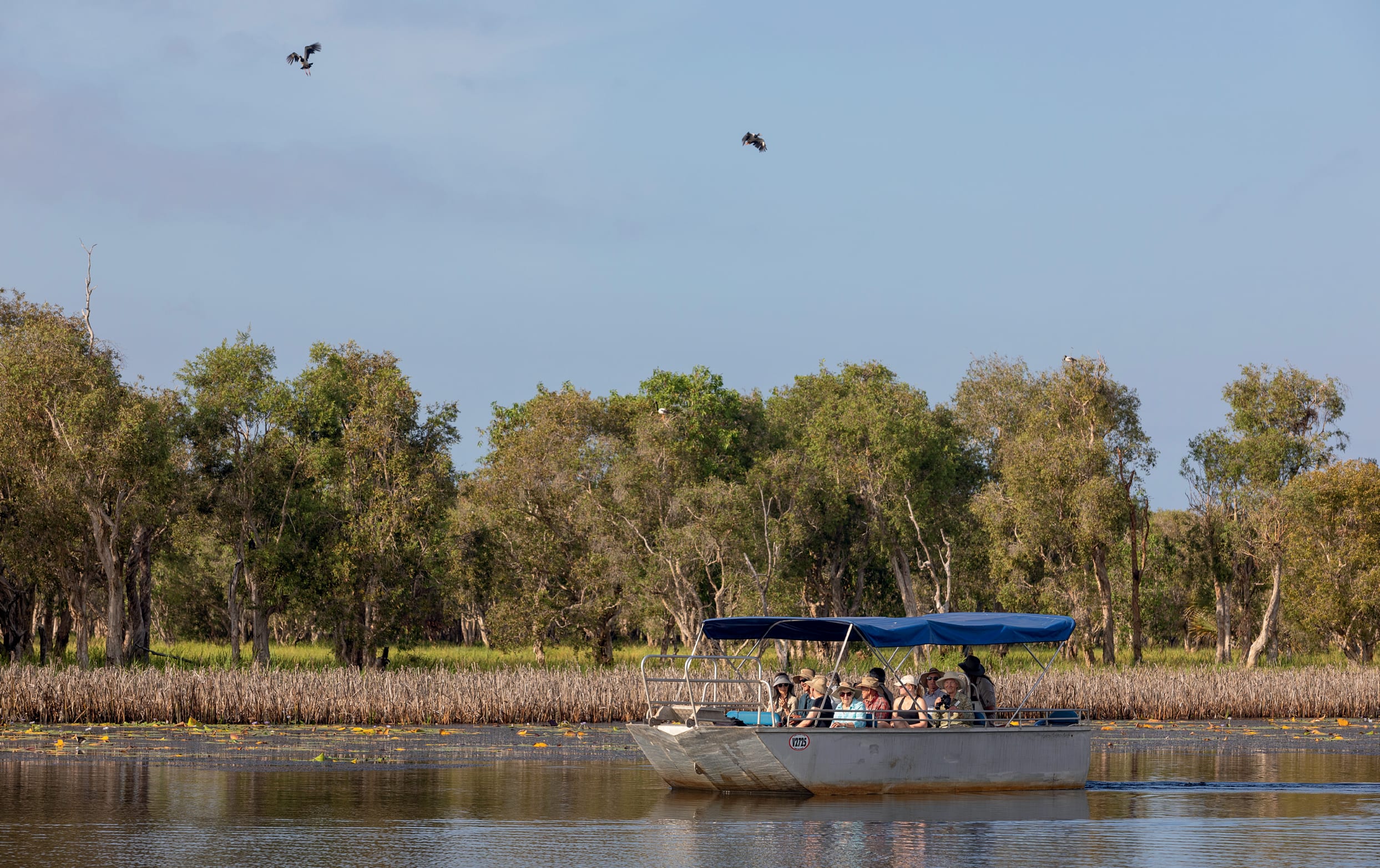
Arafura Swamp cruise on the Glyde River lagoon.
From Nhulunbuy, Sauce and his passengers set off on the jarring westward journey to Murwangi for 2 nights before moving on to Barramundi Lodge. “If you like fishing for barramundi, you’ve landed in one of the best places to do it,” trumpets Trevor Robb, the lodge’s veteran fishing guide. “We call it the land of plenty, not the land of giants. You can catch bigger ‘barras’ around Darwin, but you won’t catch as many as you do around here and the reason is the extensive tidal waterways. The Liverpool, Tomkinson and Mann rivers, as well as their creeks and tributaries, all flow out to sea near Maningrida and have a well-earned reputation for offering some of the best barra fishing in the world.”
Guests are split into 2 during morning and afternoon shifts, rotating between fishing and visiting the Maningrida Art Centre and Djómi Museum. The museum houses one of the oldest community-owned artwork collections in Australia, featuring paintings, crafts and artefacts from Maningrida and its surrounding outstations.
Arnhem Land, believed to be home to the oldest living culture on Earth, contains a diversity of languages, customs and laws. In the country surrounding Maningrida alone, 12 languages are spoken among a population numbering around 3000 people, making this the most linguistically diverse region on Earth on a per capita basis.
“We have different languages but share one culture. And we understand each other when we speak,” says Kunibidji woman, Doreen Olsen, who guides the Outback Spirit crew around the museum and art gallery, partnered by fellow Kunibidji woman, Frida Ali.
That diversity is apparent inside the museum, where exhibits include decorative ceremonial costumes from different clans. There are also fish traps and freshwater canoes made from stringybark using a design that was said to have been passed on by Macassan traders.
The next camp nestles among the stone country of west Arnhem Land. Simple ensuite cabins form a ring around a central eco-lodge at Davidson’s Arnhem Land Safaris, where eucalypts and pandanus palms mask a stunning escarpment that stretches for more than 400km from north to south, and across the East Alligator River into Kakadu National Park to the west. Former buffalo hunter Max Davidson set up the camp on sacred Aboriginal country in 1986 after befriending Amurdak elder, Charlie Manguld. The pair agreed to work together on an eco-tourism venture that would be sympathetic towards the cultural sensitivities of its traditional custodians.
It was during his hunting forays prior to that moment that Max found some of the most intricate and varied rock art in the Top End. Subjects ranged from extinct animals such as the thylacine to European firearms and 20th-century sailing ships. Techniques included stencils and the use of beeswax to portray bodily features, and many artworks had been painted over repeatedly.
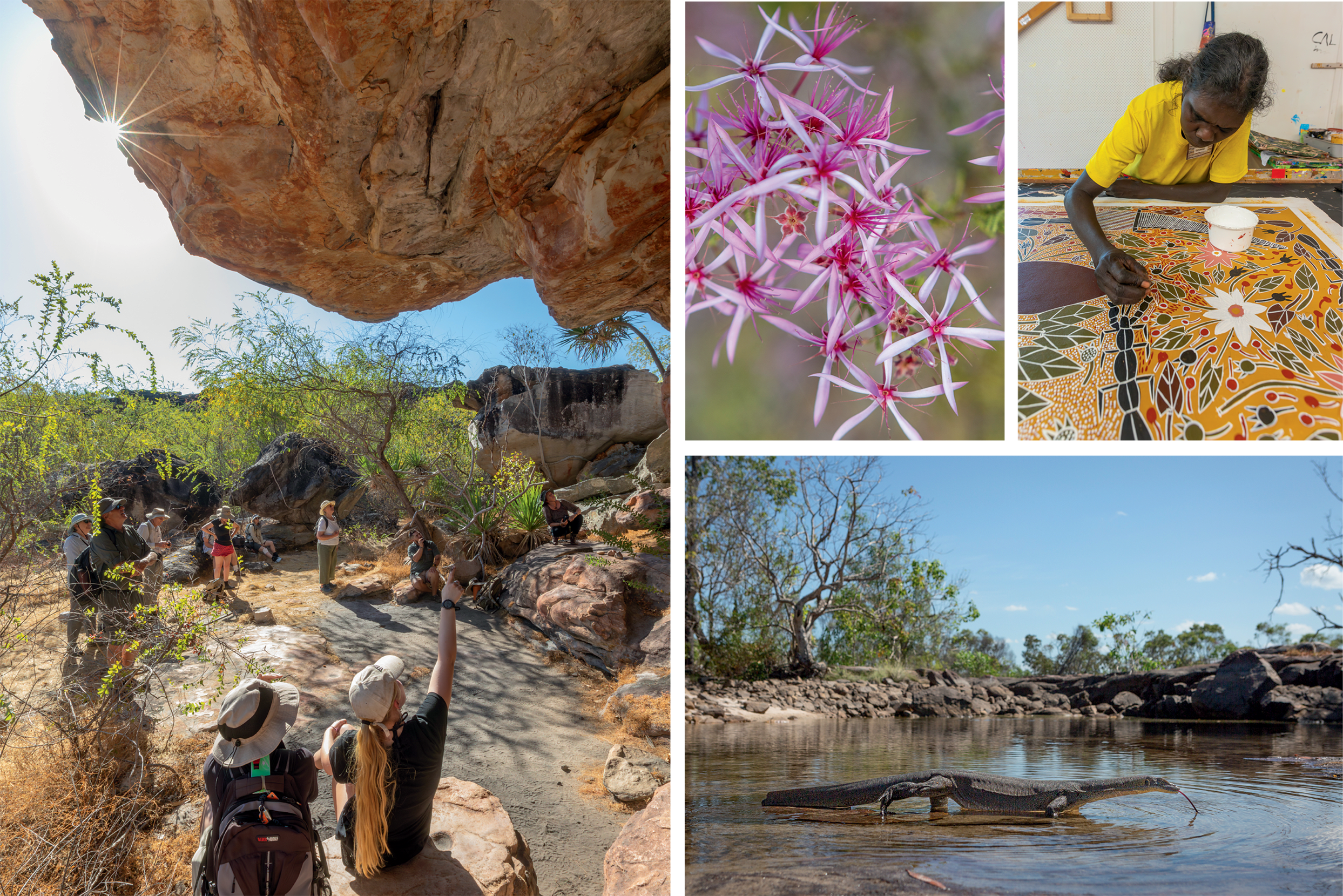
Murwangi Safari Camp; Bula Bula Art Centre artist, Evonne Gayuwrri; Merten’s water monitor, Mount Borradaile; Aboriginal rock art gallery, Davidson’s Arnhemland Safaris, Mount Borradaile; turkey bush.
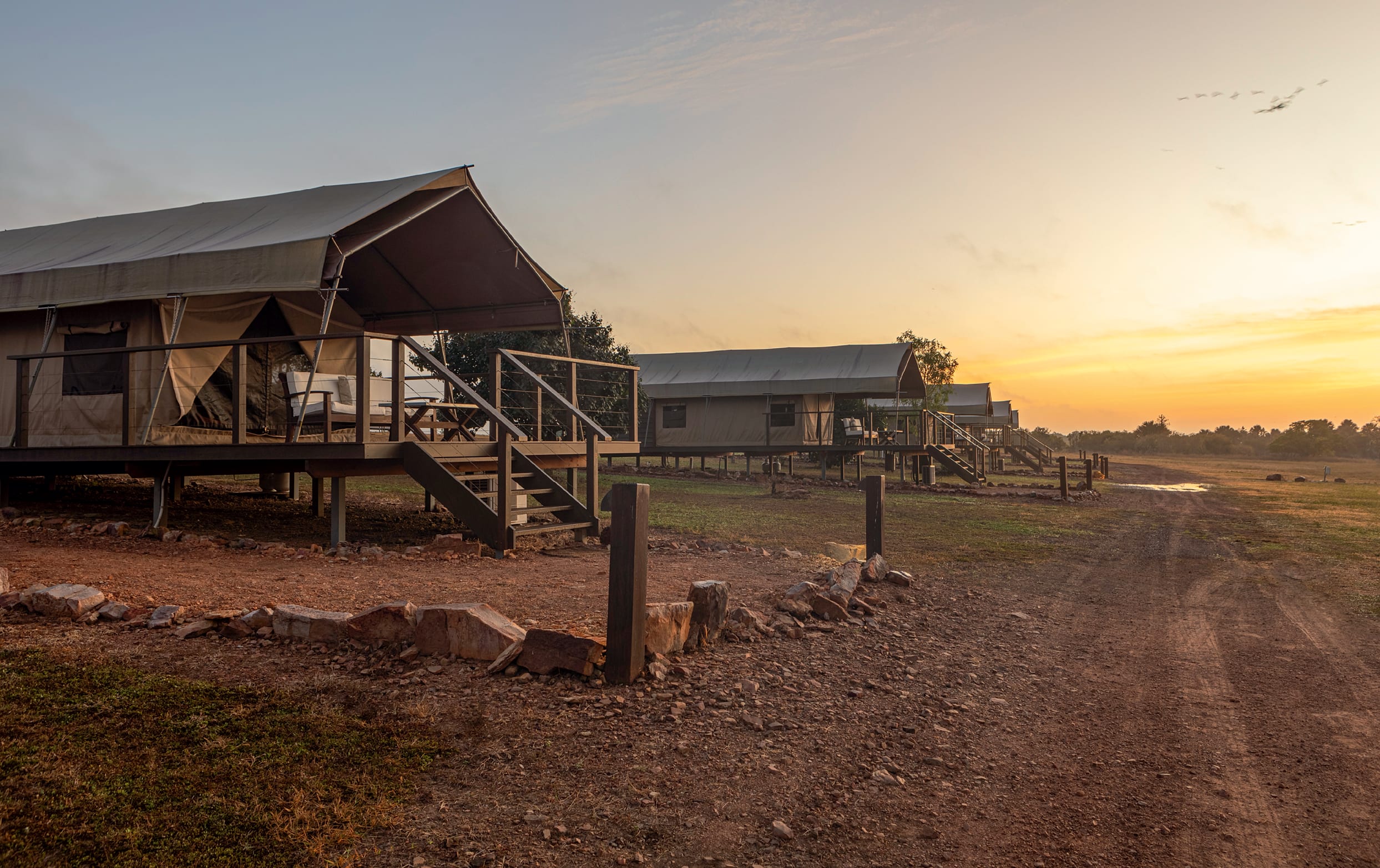
Tented accommodation at Outback Spirit’s Murwangi Safari Camp.
“This entire region was underwater 140,000 years ago,” explains camp guide Ryan Jones. “The water level peaked about 6000 years ago. Later, it became semi-arid desert, then came the estuarine period. Monsoonal rains started, resulting in freshwater build-up. The saltwater regions became clogged, eventually becoming freshwater billabongs like you see now.
“The art here reflects the time when it was painted. There are examples of fish and crocodiles and fruit bats from the estuarine period. There are paintings of thylacines, which tells us they populated this area at some stage. Dynamic figures and X-ray images evolved over time.
“Most of what we see now is mainly freshwater-style art from the last 2–3,000 years. Anything with white ochre is essentially from the freshwater period of art.”
The plush comforts and manicured gardens at Seven Spirit Bay allow guests to relax with cocktails on the sundeck or laze by the swimming pool at the end of their journey, contrasting with the hardships endured by British soldiers and their families who were stationed at one of the Top End’s pioneering European outposts, further inside Port Essington. After failed attempts to establish a British trading port on Melville Island, then at Fort Wellington, the foundations for Victoria Settlement were laid in 1838. By 1849, the fledgling community had been abandoned.
“They tried hard to make it happen,” explains Seven Spirit Bay guide, Jess Collins, during a walking tour around the settlement, inside the Garig Gunak Barlu National Park. “They built a church and a theatre. They put on plays where men dressed as women and women dressed as men. They organised games of cricket. But, being British soldiers, they were expected to wear full uniform with multiple layers in this heat. Imagine putting up with that for 11 years.”
It is difficult to imagine, when resort guests can fish for Spanish mackerel inside oceanic inlets, scour riverbanks for rare nipa palms or tiptoe along sandy beaches gouged with fresh crocodile tracks during their 3-night stay at Seven Spirit Bay. If that’s not enough pampering, a 6-course degustation meal flavoured using native bush herbs features on the final night, complemented by a generous selection of beers, wines and spirits.
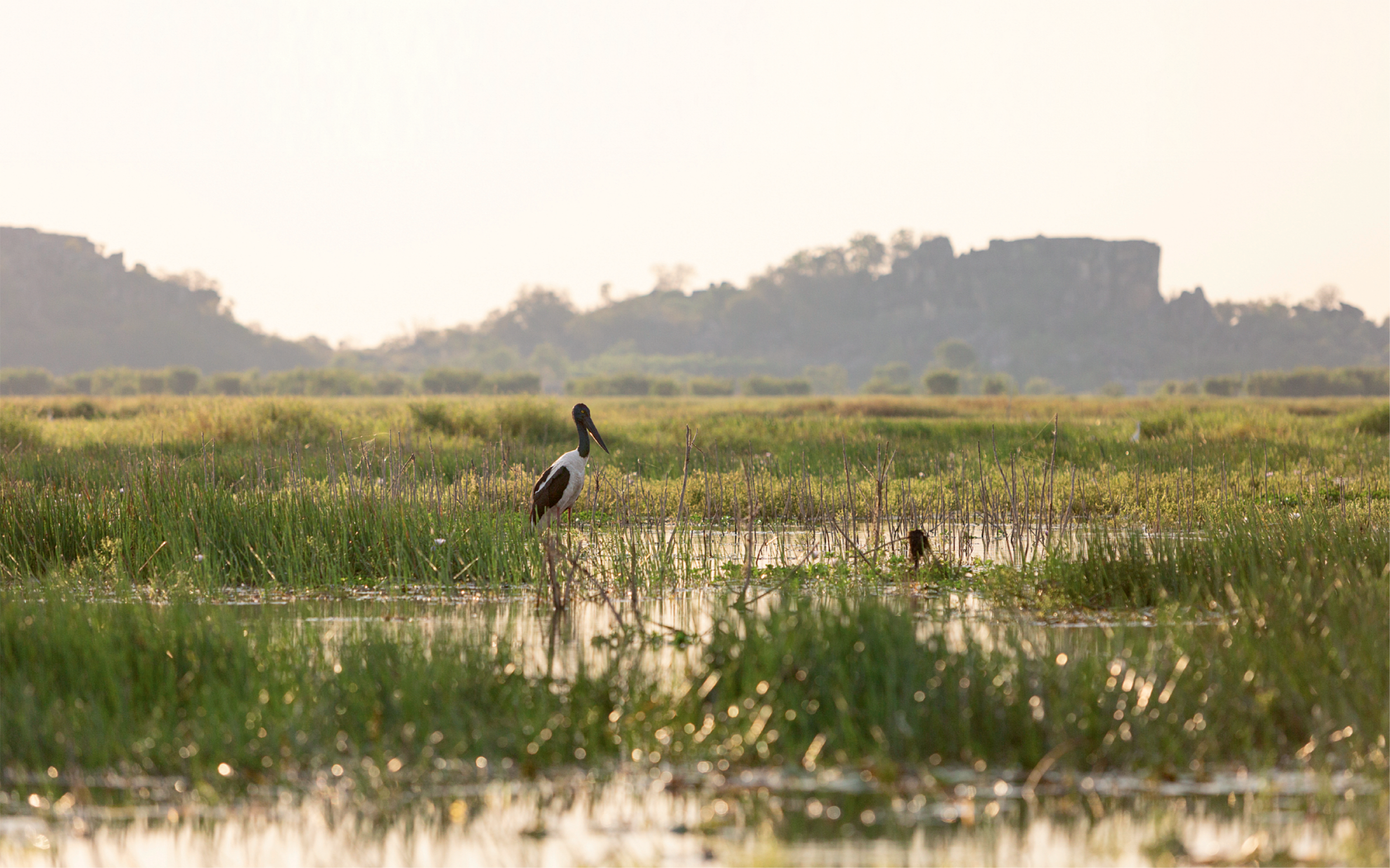
A jabiru or black-necked stork in the Cooper Creek
wetlands, Davidson’s Arnhemland Safaris.